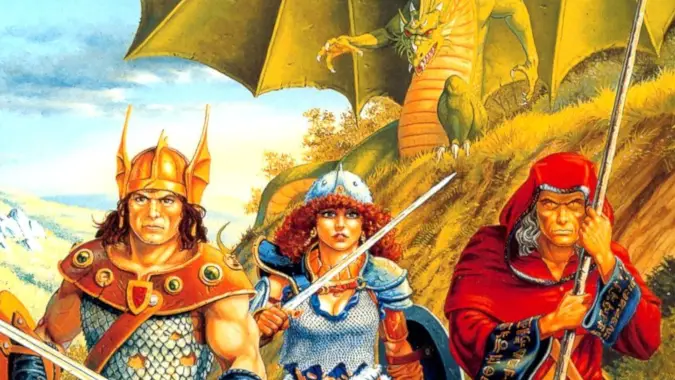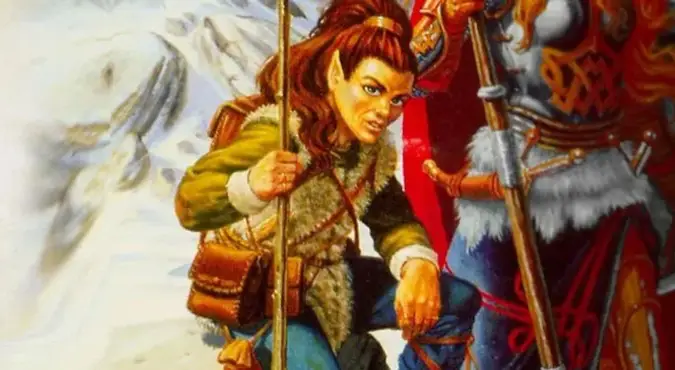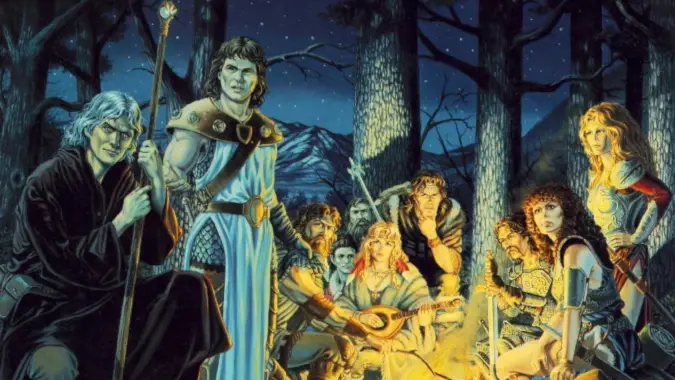Latest D&D playtest brings the classic Dragonlance setting into 5th Edition

One of the best things about 5th Edition Dungeons and Dragons is the regular release of Unearthed Arcana playtest content, where players can take new concepts out for a spin and give feedback on what works and what doesn’t. UA features don’t always make the cut, like multiclass subclasses, but sometimes we get cool previews new races, subclasses, and spells that came out in future products. (And we’re still holding out hope that this UA featuring homages to games long out of print might show up in a book eventually.) And the latest UA is a blast from the past, with the long-awaited return of the Dragonlance series to D&D — the first mention of Dragonlance player options in D&D 5e.
If you’ve never heard of Dragonlance, it was a series of fantasy novels and a set of modules for the Advanced Dungeons and Dragons game that introduced many people to D&D. While I’d already been playing the game for a few years when Dragonlance came out, I must confess that the world — originally created by Laura and Tracy Hickman, and expanded in novel form by Tracy Hickman and Margaret Weis — did a lot to help me get other people to play it. It’s one of the cornerstones of the game.
So let’s take a look at the Dragonlance content included in the latest Unearthed Arcana for play testing.

New race: Kender
Kender — the playable race of Tasslehoff Burrfoot himself — are a very divisive subject among D&D players. Their innate curiosity and lack of understanding of the concept of personal property can make them natural Rogues, but can also lead to a lot of player disagreement over whether that magic sword should be in the Kender’s bag or not. Honestly, I’m surprised Wizards didn’t just make Kender a Halfling subrace like Lightfoot or Ghostwise, but I can understand why the designers might opt to make Kender its own unique thing.
This time around, Kender get a mystical curiosity and packrat nature so strong that they can literally roll a dice and see if they have a cool magic item or plot McGuffin in their bags, having absentmindedly picked it up somewhere on their adventures, and the ability to taunt people so effectively that they get disadvantage on their next attack roll. Otherwise they’re exactly what Kender have always been — short, curious, and ridiculously brave considering they’re three feet tall and they’ll steal a greatsword from a Draconian just because it’s pretty and they want to take a closer look at it.

New Sorcerer subclass: Lunar Magic
The moons of the Dragonlance world of Krynn — and many moons of other D&D worlds — are mysterious, magical places with connections to gods and ancient lore. The new Lunar Magic Sorcerer plays into this theme, with sorcerers who can draw upon the might of the moon. This makes a lot of sense for Kyrnn, as the three moons are where the three gods of magic reside and which the three schools of High Sorcery draw their power from, but could easily fit into other D&D settings.
It’s a fun and interesting Sorcerer subclass with some unique abilities.
Level 1:
- Moon Fire is basically just the Sacred Flame cantrip, but you can use it to target two creatures if they’re standing five feet from each other.
- Lunar Embodiment grants you extra spells (which are considered Sorcerer spells) as you level up. Each spell is based on phases of the moon, so you have New Moon, Full Moon, and Crescent Moon spells:
- Full Moon spells are Faerie Fire, Moonbeam, Death Ward, Freedom of Movement, and Mass Cure Wounds
- New Moon spells are Dissonant Whispers, Darkness, Bestow Curse, Evard’s Black Tentacles, and Mislead
- Crescent Moon spells are Sanctuary, Blindness/Deafness, Phantom Steed, Hallucinatory Terrain, and Dream
At the start of every day, you choose which phase of the moon you’ll embody and therefore which spell list you have access to. That means you could go Full Moon if you expected to take a lot of damage and wanted that Mass Curse Wounds, but use New Moon if you needed to dish out a lot of damage.
Level 6:
- Lunar Boons reduce the Sorcery point cost of using Metamagic on spells in the spell schools associated with the schools of magic chosen of your current lunar phase, and it might impact how you choose your lunar phase for the day. Full Moon is abjuration and conjuration spells, New Moon is evocation and necromancy spells, and Crescent Moon is divination and transmutation spells.
- Waxing and Waning lets you switch phases as a bonus action for 1 Sorcery point. This immediately switches the spells you have access to, meaning you could immediately give yourself the ability to cast powerful spells like Mass Cure Wounds or Evard’s Black Tentacles. This gives Lunar Magic Sorcerers more spell flexibility than any other class.
Level 14:
Lunar Empowerment gives you unique benefits based on which lunar phase yo. Obviously if you change your phase we’re in — though you can swap them with Waxing and Waning if you need to.
- Full Moon: You shed a bright light within a 10 foot radius, with dim light for another 10 feet. You and anyone you choose within 10 feet of you has advantage on saving throws.
- New Moon: Advantage on Stealth checks, and anyone attacking you in dim light or darkness has disadvantage.
- Crescent Moon: Resistance to Necrotic and Radiant damage.
Level 18:
Lunar Phenomenon lets you use a bonus action to amp up the effects of your current lunar phase to new heights:
- Full Moon blinds everyone within 30 feet of you if they fail a Con save vs the caster’s spell DC. You can also choose one character in that radius to be healed for 3d8 hit points.
- New Moon radiates a field of dreadful gloom, everyone in 30 feet of you must make a Dex save or take 3d8 Necrotic damage and have their speed reduced to 0 until the next turn. Plus the Sorcerer becomes invisible until the end of their next turn, unless they attack or cast a spell.
- Crescent Moon teleports you to an unoccupied space you can see within 60 feet, and gives resistance to all damage until the start of their next turn.
If you use your bonus action to switch phases, you can immediately piggyback Lunar Phenomenon, using it immediately on switching during that bonus action. Lunar Phenomenon can be used once per long rest.

New Backgrounds: Mage of High Sorcery and Knight of Solamnia
These new backgrounds let characters of any class join the ranks of these storied Dragonlance organizations, so your Fighter can join the Mages of High Sorcery and your Sorcerer can be a Knight of Solamnia. However, you’ll want to pick your Background carefully, as each is tailored to a specific playstyle. Unsurprisingly, Knights of Solamnia are geared towards physical combat, and Mages of High Sorcery are geared towards casting spells.
Still, there are interesting options for hybrid classes here. An Eldritch Knight Fighter or Arcane Trickster Rogue might get a lot from studying with the Mages of High Sorcery, while a Bladesinger Wizard, or any Bard or Paladin might gain potent combat benefits from the Knights of Solamnia.
Each of these Backgrounds gains immediate access to a Feat that give them significant benefits in either spellcasting or combat:
- Squire of Solamnia for Knights gives proficiency in medium armor and martial weapons, opening up interesting options for spellcasters. You can also give characters within 30 feet advantage on a saving throw once per long rest.
- Initiate of High Sorcery for Mages gives access to one cantrip and one Wizard spell, which you can cast without a spell slot.
Each background has the choice of additional Feats whenever they’re able to select a Feat, giving them abilities that show their advancement within the organization. All in all, there’s a lot of flavor in these Backgrounds — and you could probably drop these organizations into any D&D setting, not just Dragonlance.
This playtest document makes it almost certain that we’ll see a full-fledged Dragonlance setting book in either 2022 or 2023. But for now, you could drop any of this content into your own games if you were so inclined.
Please consider supporting our Patreon!
Join the Discussion
Blizzard Watch is a safe space for all readers. By leaving comments on this site you agree to follow our commenting and community guidelines.
 @MatthewWRossi
@MatthewWRossi



